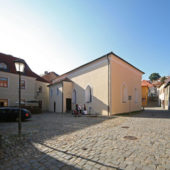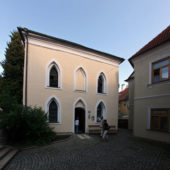Built on the remains of very old wooden prayer house.
Built in 1642, the Front Synagogue derives its name from its location on the western edge of the Jewish Quarter along the banks of the Jihlava River in Trebic. The quarter, called the Zamosti, meaning “behind the bridge,” was the home of Trebic’s Jews for more than four centuries. In keeping with the laws and practices of the time, the Jews were separated from the rest of the population and often awarded less desirable land. In this case, the land was located along the riverbanks and was prone to annual flooding. The Front Synagogue was constructed at the entrance of the quarter. The building itself replaced an earlier wooden structure.
Constructed in Baroque style, the synagogue’s rectangular layout provided seating for 114 men in benches along the walls with room for 80 women in a second floor gallery accessible by a separate staircase. Local records indicate that the synagogue was an impressive structure, dominating Trebic’s modest skyline with Sabbath candle illuminations that could be seen from long distances. This upset the wife of the local lord, who in 1757 ordered the building to be lowered. It was in this era that Trebic’s Jewish community reached its zenith of 1,770 people, forming nearly 60 percent of the town’s population as they prospered, in spite of “protection taxes”, in commerce, distilling, soap making, tanning and other occupations. Subsequent fires and a major renovation in 1856-57 gave the synagogue its largely neo-gothic style apparent today. When a later synagogue was built in the 18th Century, the Front Synagogue also became known as the Altschul.
The synagogue is a simple, hip-roofed structure which was entered through a small porch on the western side. A raised pulpit stood next to the tabernacle on a small platform enclosed by a balustrade. The women’s second floor gallery is supported by two massive pillars above which is the vaulted ceiling, illuminated by windows on either side.
By the middle of the 19th century, an emancipation law freed the Jews to live where they pleased and thus began a slow but steady outflow of Jews from Trebic. In spite of this, the Front Synagogue continued to be used for worship well into the 20th Century until the remaining Jews were deported by the Nazis to concentration camps. A handful of survivors returned from the Holocaust but were unable to refurbish the synagogue which had been damaged during the war and used for storage.
The Czech Brethren purchased the building in 1952 and turned it into a Hussite Church which it remains today. The entire Jewish Quarter of Trebic in 2003 was named a World Heritage Site by UNESCO, ostensibly the only Jewish monument so named outside of Israel. No Jews reside in Trebic in 2008, the year this was written.


